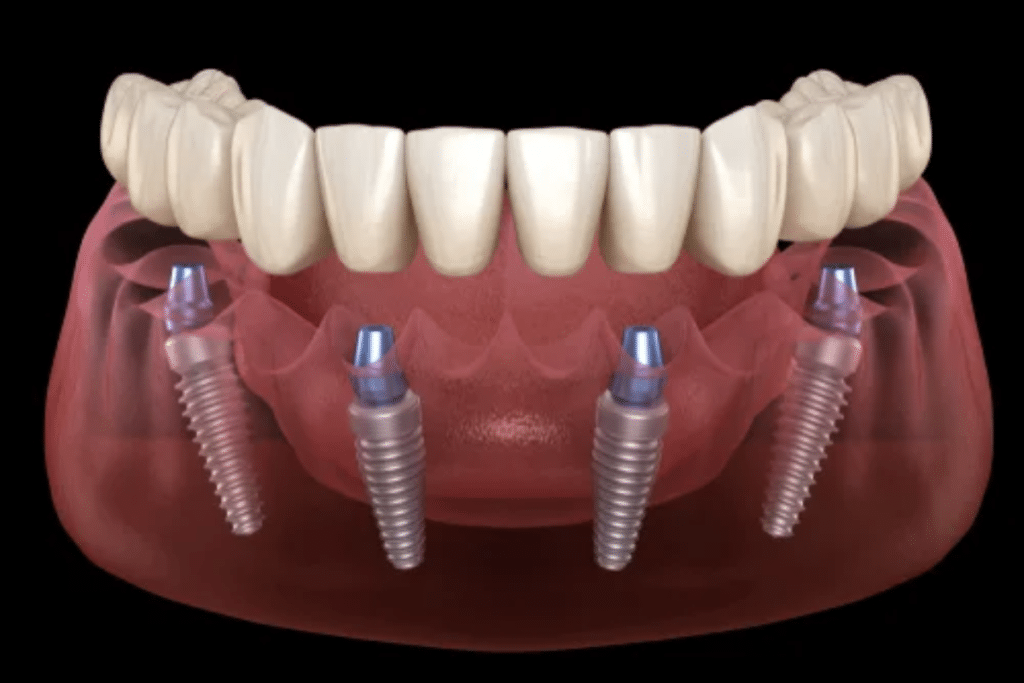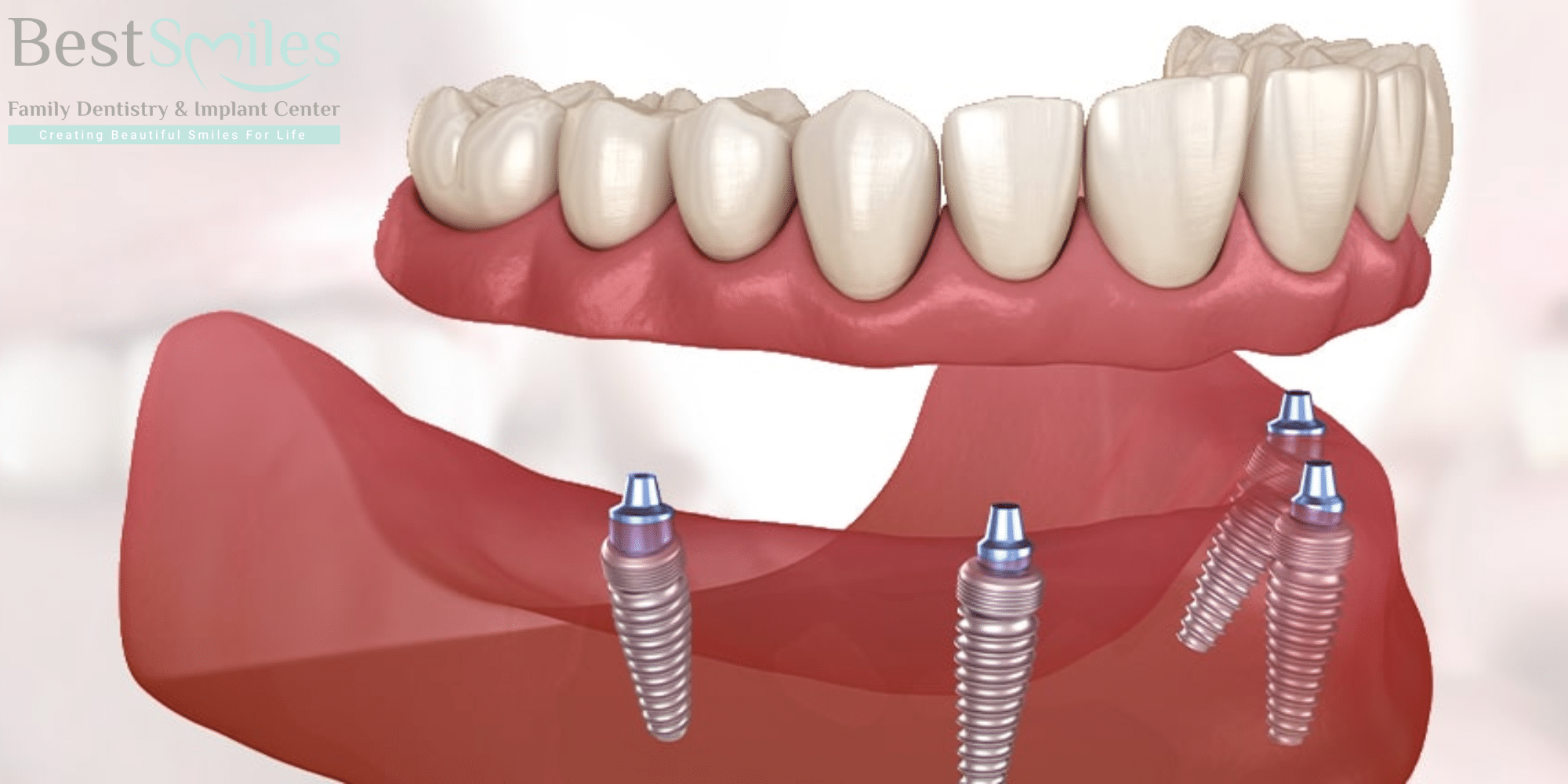Ditch the dentures and gummy smiles! Dental implants are the game-changer for missing teeth, offering a rock-solid, natural-looking solution. But let’s be honest, the word “implant” can sound intimidating.
Are you wondering if getting a full arch of teeth replaced with All-On-4 implants means enduring jaw-clenching pain?
The All-On-4 implant technique, which uses four strategically placed implants to support a full arch of replacement teeth, has gained popularity for its efficiency and effectiveness. However, a common concern among patients is whether the procedure is painful.
This blog will answer all your questions about discomfort during the All-On-4 procedure. We’ll explore what to expect and how modern dentistry keeps you feeling comfortable throughout the process. So, ditch the worry and get ready to smile with confidence!
Understanding All-On-4 Implants
All-On-4 implants offer a unique approach to dental restoration. Unlike traditional methods that require individual implants for each missing tooth, All-On-4 utilizes four implants to support a full set of upper or lower teeth. This technique minimizes the need for bone grafting, reduces surgery time, and often allows for immediate placement of temporary teeth.
Key Benefits:
- Fewer implants required: The All-On-4 technique uses only four implants per arch, making the procedure less invasive.
- Avoids the need for bone grafts: Implants are placed in areas with sufficient bone density, often eliminating the need for additional procedures.
- Faster recovery and immediate function: Patients receive a complete set of temporary teeth on the same day, allowing them to eat and speak comfortably during the healing period.

The All-on-4 Implants Procedure Explained
The All-On-4 implant procedure involves several stages, each crucial for the overall success and comfort of the treatment.
Consultation and Planning:
- Initial examination and imaging (X-rays or CT scans) to assess bone structure
- Custom treatment plan tailored to individual needs
Surgical Phase:
- Local anesthesia or sedation to ensure comfort
- Precise placement of four titanium implants into the jawbone
- Temporary teeth attached to implants on the same day
Healing and Final Restoration:
- Healing period of 3-6 months for implants to integrate with the bone
- Final set of permanent teeth placed once healing is complete
Pain During the Procedure
One of the most common questions about All-On-4 implants concerns the pain during the procedure. Thanks to modern anesthesia and sedation techniques, most patients experience minimal discomfort during the surgery.
Anesthesia Options:
- Local Anesthesia: This option numbs the surgical area, effectively eliminating pain. The patient remains awake but does not feel any sharp pain during the implant placement.
- Sedation (Oral or IV): Sedation helps patients relax significantly. Oral sedation involves taking medication before the procedure to reduce anxiety, while IV sedation is administered directly into the bloodstream for a deeper state of relaxation. Many patients experience partial or complete amnesia of the procedure, meaning they have little to no memory of the surgery.
Patient Experiences:
- Minimal Pain: Many patients report feeling pressure during the implant placement but no significant pain. The sensation is more of a dull pressure rather than sharp discomfort, which makes the experience more tolerable.
- Reduced Anxiety and Discomfort: Sedation plays a crucial role in reducing anxiety and discomfort. Patients who opt for sedation often feel much more at ease throughout the procedure, allowing them to undergo the surgery without significant stress or fear.
Overall, the combination of local anesthesia and sedation ensures that the All-On-4 implant procedure is as comfortable as possible for patients.
Post-Surgery Discomfort
Post-surgery discomfort is a natural part of the healing process. Understanding what to expect can help you manage any pain effectively.
Common Post-Surgery Symptoms:
- Swelling and bruising around the surgical site
- Mild to moderate pain, manageable with prescribed pain relievers
- Minor bleeding or oozing for the first 24-48 hours
Pain Management:
- Over-the-counter pain medications like ibuprofen or acetaminophen
- Prescription pain relievers for more severe discomfort
- Ice packs to reduce swelling and inflammation
Tips for a Smooth Recovery
A smooth recovery involves following your dentist’s post-operative care instructions and taking steps to ensure optimal healing.
Post-Operative Care:
- Follow a soft food diet for the first few days
- Maintain oral hygiene with gentle brushing and rinsing
- Avoid strenuous activities and smoking
Healing Aids:
- Stay hydrated to support overall health and healing
- Use saltwater rinses to keep the mouth clean
- Attend follow-up appointments to monitor progress
When to Contact Your Dentist?
While some discomfort is normal, certain symptoms may indicate complications that require prompt attention.
Signs to Watch For:
- Severe or persistent pain not relieved by medication
- Excessive swelling or bruising after a few days
- Signs of infection, such as fever, pus, or foul odor
Immediate Actions:
- Contact your dentist immediately if you experience any of these symptoms
- Follow all given instructions for managing complications
Getting All-On-4 implants involves some discomfort, but modern dental techniques and proper pain management make the experience more comfortable than you might expect. The benefits of restored function and aesthetics far outweigh the temporary discomfort. Always consult with your dentist to understand the procedure, manage expectations, and ensure a smooth recovery.




